November 10, 2019
Fall was certainly brief and summer is already a distant memory. The shop stove was lit yesterday when the inside temp hit 40°F and the first winter snowfall is forecast to begin this afternoon. This morning there was just enough time to get the driveway and walkway markers down and to clear the last blanket of fall leaves from the lawn. Outside of changing mailbox post reflectors to keep the town plow truck away and wrapping the boxwood bushes in burlap, I think we are pretty much set for whatever winter will bring.
It has been a busy month. Warm weather equipment had to be serviced and prepped for winter so it will be ready in the spring. Winter equipment had to be serviced, prepped and checked out to make sure it is ready to go. Quite a bit of difference from when we lived in a small home, on a small lot in California; no snow, $100 a month lawn service and neighbors were close in and all around. Living in rural Maine is a challenge, but a good one that leads to continued personal satisfaction and an ongoing learning experience. Trying to explain the benefits of rural living to a person who has always lived life in urban centers is difficult and nearly impossible when it comes to an appreciation of firearms.
The enigmatic 44-40 WCF… Yeah, not really
The 44-40 Winchester cartridge was initially designed for the then new Winchester Model 1873 as a black powder cartridge. Its popularity saw it picked up by numerous other manufacturers for use in lever action, pump action and single shot rifles, as well as in Colt revolvers. By 1937 there were no production rifles chambered for the 44-40 WCF cartridge and by 1942 there were no handguns offered in that chamber. Use of the 44-40 Winchester in Cowboy Action Shooting events, new Winchester production and production of historical replica firearms have revived the cartridge once again.
Compared to similar size cartridges that are commonly chambered for rifles and handgun:
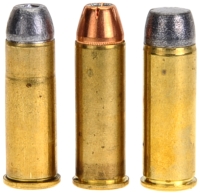
| Cartridge | Case Length” |
Overall Length” |
Net O2 Capacity |
MAP PSI |
| 44-40 WCF | 1.305 | 1.592 | 40.0 | 11k |
| 44 Rem Mag | 1.285 | 1.610 | 39.5 | 36k |
| 45 Colt | 1.285 | 1.600 | 41.60 | 14k |
Handloading the 44-40 Winchester for the Winchester Model 1873 requires a bit of patience and restraint. As indicated on the table above, the 44-40 Winchester operates at pressure levels consistent with other black powder cartridges that have carried over into smokeless powder versions. Factory ammunition adheres to the SAAMI Pressure specifications, including Buffalo Bore.
Handload data in recent mainstream releases also stays to the SAAMI specification with the exception of the Lyman Cast Bullet Handbook 4th Edition. Lyman provides extended data by grouping firearms listed as Group I weaker actions and Group 2 stronger actions. As an example, the 1873 is in the weaker category, the 1892 is in the stronger category. The modern Winchester Model 1873 represents resumption of production based on the original but with modern materials and processes, however, the design is intended for low pressure, short cartridges. Compared to the Model 1892…

As indicated by the dotted reference line, the Winchester’s two forward pins are above the plane of the third pin. This assures that bolt force will be transferred back to the large boss at the rear of the receiver. The safety catch assures this orientation before the rifle can be discharged. A good number of reproduction rifles position the center pin slightly below the plane of the aft pin. This directs force downward to the lever upon firing rather than to the substantial boss at the rear of the receiver, which significantly reduced the strength of those actions.
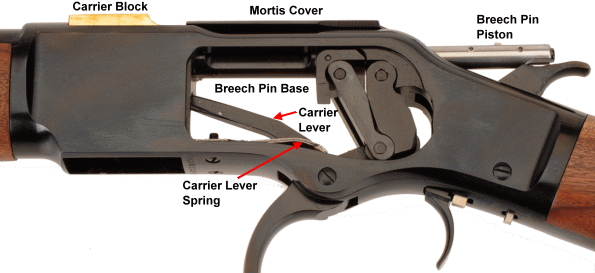
Cycling the lever back opens the mortis cover, pulls the breech bolt assembly aft, collapses the pinned link assemblies and the bolt cocks the rifle’s hammer. During this stroke, the carrier lever raises the carrier block with a fresh round into alignment with the rifle’s chamber. As the lever is cycled closed, the breech bolt assembly moves forward and charges the rifle’s chamber as the carrier block is lowered back down to receive another round from the rifle’s tubular magazine.
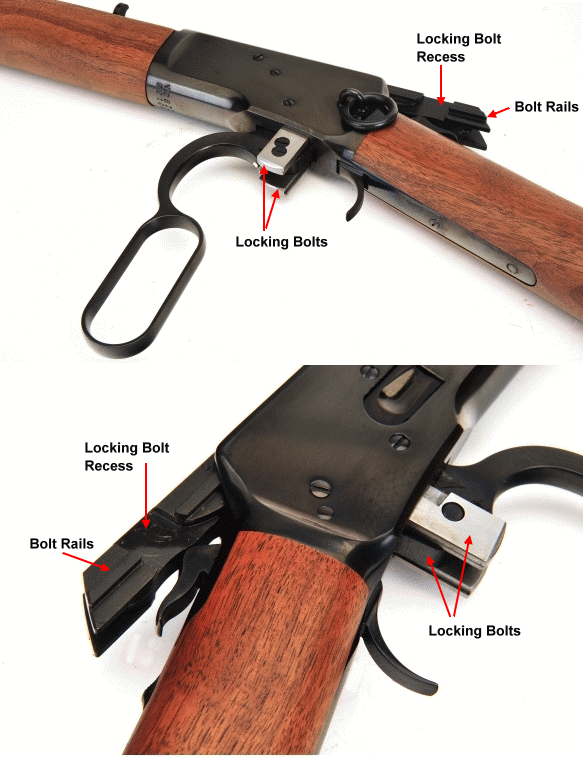
At the request of Winchester, John Browning designed the Model 1892 with the objective of creating a stronger, lighter replacement for the Winchester Model 1873. Based on Browning’s earlier Model 1886 design, the Model 1892 was scaled down for use with shorter cartridges. Where the Model 1886 accommodated the 2.850″ 45-90 WCF, The Model 1892 was designed to accommodate the 44-40 WCF’s 1.592″ length. Common to both the Models 1886 and 1892 are vertical locking bolts, a breech bolt that interlocks with the locking bolts on a perpendicular plane and to the receiver on a longitudinal plane and a solid bottom receiver. They are stout.
Consequently, loading to the proper firearm group assignment is critical and data provides in older manuals should not be used for the Model 1873. As an example, a group I load appropriate for the modern Model 1873 is a 200 grain cast bullet over 17 grains of IMR 4227@ 1,310 fps with a pressure level a shade over 10,000 PSI. Lyman Reloader’s Handbook, 42nd Edition lists 29 grains of IMR 4227 for a 200 grain cast bullets @1,990 fps with a pressure level of approximately 43,000 psi; 30% greater charge and about twice the pressure of any current listings for even the Winchester Model 1892. nearly twice the pressure of the currently. Load the latter in any Model 1873 and you’ll be hearing Patsy Cline singing “I fall to pieces”.
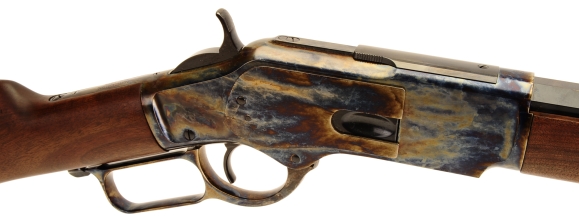
For my narrow perspective, the current Model 1873 and 44-40 WCF is a terrific combination for folks with an interest is history, participants in related shooting events or anyone who appreciates a nicely finished, good looking firearm. For the deer hunter who wants to experience what it was like to to hunt with this classic firearms, the current Model 1873 would accommodate. For people with other preferences, the Model 1873 is also available in 357 Mag/38 Special and 45 Colt with standard pressure loads. For the modern hunter looking for 44 Magnum or modern high pressure 45 Colt power, the Model 92 is the way to go.
44-40 WCF idiosyncrasies
The 44-40 Winchester has a SAAMI specification bullet diameter of 0.4270″ +0.0000″/-0.0030″. The case case mouth diameter is 0.4430″ +0.0020″/-0.0000″. The chamber just prior to the throat is 0.4436 +0.0020″/-0.0000″. The groove diameter is 0.4285″ +0.0020″/-0.0000″.
By comparison, the 44 Remington Magnum bullet diameter specification is 0.4320″ +0.0000″/-0.0030″. The 44 Magnum case mouth spec is 0.4560″ +0.0040″/-0.0000″ diameter. The chamber at the mouth location is 0.4580″ +0.0040″/-0.0000″. The groove diameter is 0.4310″ +0.0040″/-0.0000″.
By specification, the 44-40 Winchester and 44 Remington Magnum so not share a common bullet or groove diameter. Winchester cuts grooves to 0.4285″ and the chamber at the case mouth is held to the minimum chamber spec.
Some people attempt to use bullets intended for the 44 Remington Magnum, typically with a diameter of 0.4290″ to 0.4310″, in 44-40 WCF handloads. There are a number of replica guns out there that use the 44 Remington Magnum bullet diameter, groove diameter and chamber at the case mouth diameter to facilitate use of more commonly available 44 Remington Magnum bullets. Winchester builds their Model 1873 to SAAMI 44-40 Winchester specification.
Attempting to use 44 Remington Magnum bullets in concert with the 44-40 Winchester cartridge and the Winchester Model 1873 results in some problem areas. The bullet is too large for the barrels grooves which increases bore friction and pressure. Inserting a 44 Remington Magnum bullet or roll crimping substantially to the extent the case mouth exceeds a diameter of 0.4430″ will cause the assembled round not to chamber… as it should because the bullets and assembly are out of spec for the 44-40 WCF.
In addition to the issues noted, 44 Remington Magnum jacketed bullets over 200 grains will exceed overall cartridge length spec and maximum Winchester feed length if locating to the bullet cannelure, utilizing 1.305″ long brass. But where there is a will there is a way.
Again, only in reference to the subject rifle
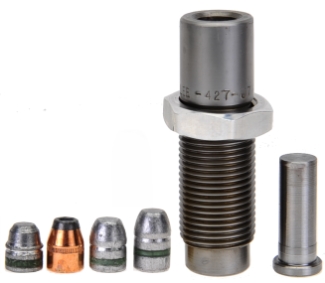 My choice of bullets, for what reasons escape me at the moment, came down to three cast and one jacketed. The cast were all listed by their manufacturer as 0.427″ diameter, the one jacketed bullet listed for the 44 Remington Magnum was listed as 0.429″ in diameter by its manufacturer.
My choice of bullets, for what reasons escape me at the moment, came down to three cast and one jacketed. The cast were all listed by their manufacturer as 0.427″ diameter, the one jacketed bullet listed for the 44 Remington Magnum was listed as 0.429″ in diameter by its manufacturer.
When I run into a rifle cartridge that could use near diameter pistol bullets, like the 350 Legend, I run the slightly oversize diameter bullet through an appropriate sizer die. In this case a Lee Precision, 0.457″ bullet sizer die.The resulting diameter will not be identical to the bullet sizer as all material has some degree of spring back, including lead alloy which is not dead soft, and jacketed bullets tend to spring back more than hard cast lead.
| Manufacturer | Bullet Weight Grains |
Raw Bullet ∅” |
Swaged Bullet ∅” |
Assembled Case Mouth ∅” |
| Hunters Supply Cast | 160 | 0.4280 | 0.4275 | 0.4415 |
| Sierra JHP | 180 | 0.4305 | 0.4285 | 0.4425 |
| Hunters Supply Cast | 200 | 0.4280 | 0.4275 | 0.4415 |
| Hunters Supply Cast | 240 | 0.4280 | 0.4275 | 0.4415 |
Lead bullets sized uniformly, the jacketed bullet came out 0.0010″ larger, but still well in spec and the assembled cartridge cycled and chambered reliably. A secondary issue came to light. Other than the 160 grain cast, all others came in with excessive cartridge overall length. The issue was addressed by trimming all cases to minimum spec of 1.285″. Case capacity after trimming was still well in excess of any useful charge so the reduction was of no consequence, however, charges were adjusted to compensate for reduced net case capacity.
The RCBS Trim Pro and loading press shell holder number for the 44-40 Winchester is #35. I used a #20 in the Trim Pro and the cases were secured and the cuts squared the case mouths. Flaring was kept to a minimum as was roll crimping as it does not take to much of either to excessively upset the case neck and prevent chambering.
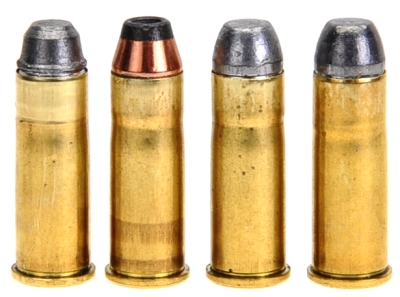
Warning: Bullet selections are specific, and loads are not valid with substitutions of different bullets of the same weight. Variations in bullet length will alter net case capacity, pressure and velocity. Primer selection is specific and primer types are not interchangeable. These are maximum loads in my firearms and may be excessive in others. All loads should be reduced by 5% as a starting point for development where cartridges have greater than 40 grains in capacity and 10% for cartridges with less than 40 grain capacity following safe handloading practices as represented in established mainstream reloading manuals. Presentation of these loads does not constitute a solicitation for their use, nor a recommendation.
| 44-40 Winchester – MAP 11,000 PSI |
|
| Firearm | Winchester 1873 |
| Barrel Length | 24.00″ |
| Max Case Length | 1.305″ +0.000″/-0.020″ |
| Min – Max COL | 1.540″ – 1.592″ |
| Primer | CCI 300 (LP) |
| Bullet Diameter | 0.4270″ +0.000″/-0.0030″ |
| Reloading Dies | Lee Precision |
| Bullet Type | Bullet Weight Grains |
Net H2O Grains Capacity |
COL” | Powder Type | Powder Charge Grains |
Muzzle Velocity fps |
Muzzle Energy ft/lbs |
50Yard 5 Shot Group” |
| Hunter’s Supply Cast FP |
160 | 31.4 | 1.575 | 2400 | 17.5 | 1328 | 627 | 1.9 |
| Hunter’s Supply Cast FP | 160 | 31.4 | 1.575 | IMR 4227 | 21.5 | 1302 | 602 | 2.4 |
| Sierra Sportmaster JHP |
180 | 29.6 | 1.591 | 2400 | 16.0 | 1233 | 608 | 2.1 |
| Sierra Sportmaster JHP |
180 | 29.6 | 1.591 | IMR 4227 | 20.0 | 1256 | 631 | 1.8 |
| Hunter’s Supply Cast FP | 200 | 29.2 | 1.580 | 2400 | 15.5 | 1151 | 588 | 1.7 |
| Hunter’s Supply Cast FP | 200 | 29.2 | 1.580 | IMR 4227 | 18.0 | 1147 | 584 | 1.6 |
| Hunters Supply Cast FP | 240 | 25.4 | 1.580 | 2400 | 12.5 | 1063 | 602 | 2.0 |
| Hunters Supply Cast FP | 240 | 25.4 | 1.580 | IMR 4227 | 16.0 | 1072 | 613 | 2.2 |
| All cases trimmed to 1.285″. Cast bullets sized to 0.4275″, jacketed to 0.4285″. Winchester 1873’s groove diameter 0.4285″ | ||||||||
Hmm…?
The Winchester Model 1873 performed admirably; reliable feed, consistent velocity and accuracy consistent with a short range hunting rifle. In fact, its accuracy with metallic sights, or at least my ability to hit with open sights is about the same as my half century+ Marlin 336 30-30 WCF and I would not hesitate to use it for deer or hog hunting. I am sure there are folks out there shooting 300 yards with a Winchester 1873 and the 44-40 WCF, for the sake of a YouTube video, but I’m not sure that is an expectation I would hold.
For kinetic energy fans with a preset notion of impact velocity and energy required to down a deer, the 44-40 WCF’s ballistics combination may seem a bit anemic. However, for folks who see the hard cast bullet’s redeeming quality of penetration, it is more than enough for short range hunting. Yes, hitting a vital target is required, but the same is also pretty much required with anything other that hand grenades.
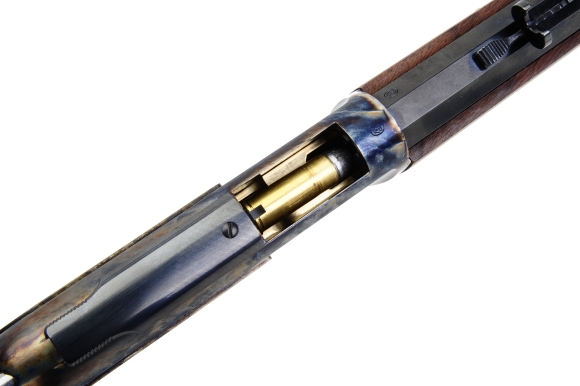
Color case hardened finish and nice walnut are pretty fancy, in a good way, but the finish isn’t fragile and the Model 1873 looks as good as it did right out of the box after a good deal of shooting and handling. I am sure there is a good deal to tinker with on handloads including bullet size, more careful assessment of chamber dimensions and maybe a tool or two that would optimize final cartridge form and, for me, that is a large part of the enjoyment that comes from firearms of this type. Glad Winchester is still producing these interesting firearms and hanging on to their history.

Email Notification